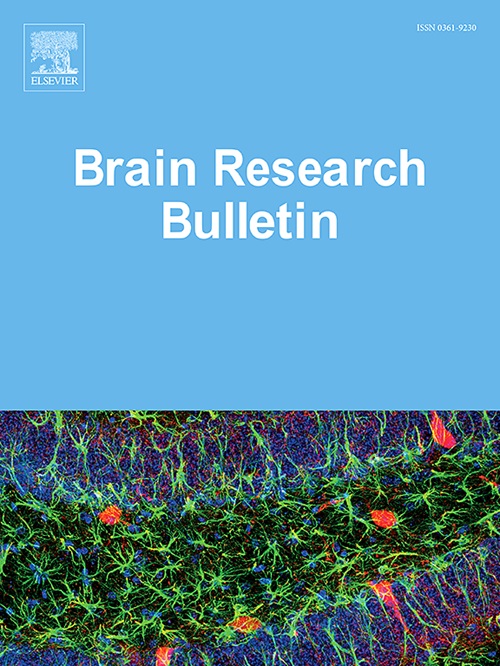Macrostructural and microstructural alterations of hippocampal subregions in T2DM: NODDI provides added value to DTI and volumetric analyses
IF 3.7
3区 医学
Q2 NEUROSCIENCES
引用次数: 0
Abstract
Objective
We explored macrostructural and microstructural changes in the hippocampal subregions of patients with type 2 diabetes mellitus (T2DM) and compared the effectiveness of neurite orientation dispersion and density imaging (NODDI) with that of traditional diffusion tensor imaging (DTI) and volumetric analysis in detecting structural alterations.
Methods
A total of 302 participants (128 T2DM patients and 174 healthy controls) underwent 3.0-T magnetic resonance imaging and neuropsychological assessments. Hippocampal subregions were segmented and registered using FreeSurfer and SPM, with DTI and NODDI analyses being performed to assess microstructural changes. Neuropsychological and clinical data were further analyzed to explore correlations with cognitive function.
Results
Significant microstructural alterations were observed in the hippocampal subregions of T2DM patients, with NODDI detecting abnormalities in approximately 70 % of the subregions, which were characterized by increased neurite density index (NDI), orientation dispersion index (ODI), and free water fraction (FWF) values, thus suggesting increased neurite density, disrupted orientation, and elevated free water content across most hippocampal subfields. DTI and NODDI analyses consistently identified the hippocampus-amygdala transition area (HATA) as a subregion that is particularly sensitive to microstructural changes in T2DM patients. Moreover, the NDI and FWF values were significantly correlated with cognitive performance, with the molecular layer and hippocampal tail exhibiting the strongest associations between microstructural indices and cognitive function.
Conclusion
This study reveals microstructural alterations in the hippocampal subregions of T2DM patients, with particular changes being observed in the HATA region, moreover, this study highlights the advantages of the NODDI model in detecting these subtle changes, thereby providing important theoretical insights for future research.
T2DM海马亚区宏观结构和微观结构改变:NODDI为DTI和体积分析提供了附加价值
目的探讨2型糖尿病(T2DM)患者海马亚区宏观结构和微观结构的变化,并比较神经突定向弥散和密度成像(NODDI)与传统弥散张量成像(DTI)和体积分析检测结构变化的有效性。方法对302例患者(T2DM患者128例,健康对照174例)进行3.0 t磁共振成像和神经心理评估。使用FreeSurfer和SPM对海马亚区进行分割和注册,并进行DTI和NODDI分析以评估微结构变化。进一步分析神经心理学和临床数据,探讨与认知功能的相关性。结果T2DM患者海马亚区微结构明显改变,NODDI检测到约70% %的亚区异常,其特征是神经突密度指数(NDI)、取向弥散指数(ODI)和自由水分数(FWF)值增加,从而表明大多数海马亚区神经突密度增加、取向破坏和自由水含量升高。DTI和NODDI分析一致认为,海马-杏仁核过渡区(HATA)是对T2DM患者微结构变化特别敏感的一个亚区。此外,NDI和FWF值与认知功能显著相关,其中分子层和海马尾的微观结构指数与认知功能的相关性最强。结论本研究揭示了T2DM患者海马亚区微结构的改变,特别是HATA区域的改变,同时本研究突出了NODDI模型在检测这些细微变化方面的优势,为今后的研究提供了重要的理论见解。
本文章由计算机程序翻译,如有差异,请以英文原文为准。
求助全文
约1分钟内获得全文
求助全文
来源期刊

Brain Research Bulletin
医学-神经科学
CiteScore
6.90
自引率
2.60%
发文量
253
审稿时长
67 days
期刊介绍:
The Brain Research Bulletin (BRB) aims to publish novel work that advances our knowledge of molecular and cellular mechanisms that underlie neural network properties associated with behavior, cognition and other brain functions during neurodevelopment and in the adult. Although clinical research is out of the Journal''s scope, the BRB also aims to publish translation research that provides insight into biological mechanisms and processes associated with neurodegeneration mechanisms, neurological diseases and neuropsychiatric disorders. The Journal is especially interested in research using novel methodologies, such as optogenetics, multielectrode array recordings and life imaging in wild-type and genetically-modified animal models, with the goal to advance our understanding of how neurons, glia and networks function in vivo.
 求助内容:
求助内容: 应助结果提醒方式:
应助结果提醒方式:


